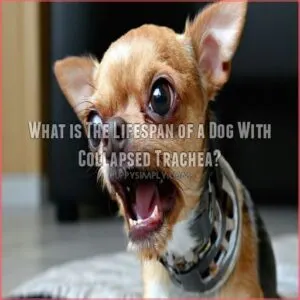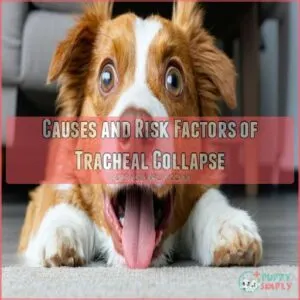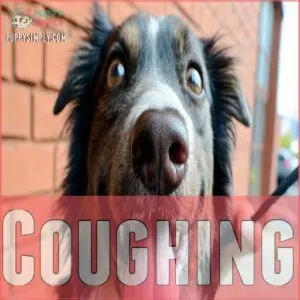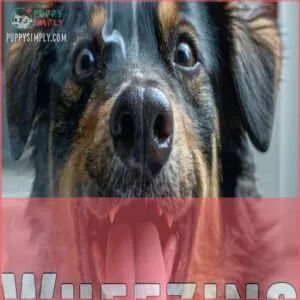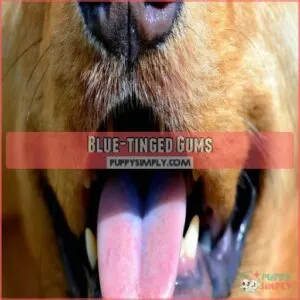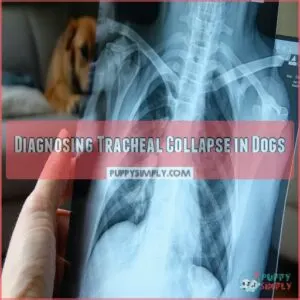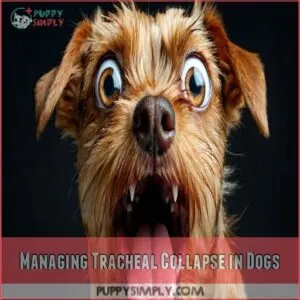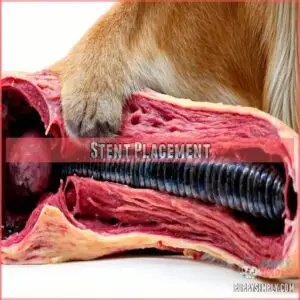This site is supported by our readers. We may earn a commission, at no cost to you, if you purchase through links.
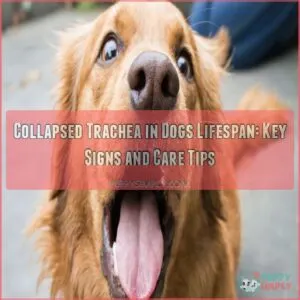 There’s no set lifespan for dogs with collapsed trachea, as it varies based on severity and progression.
There’s no set lifespan for dogs with collapsed trachea, as it varies based on severity and progression.
But don’t worry—this condition is manageable! Most pups live fairly normal lives following diagnosis.
Keep their weight in check and follow medical advice to slow down cartilage wear and tear. This can help them breathe easy and avoid pesky symptoms.
A timely vet visit can work wonders, potentially extending their life by 2-4 years.
While there’s no crystal ball, these steps can offer your canine companion a happy, wagging tail life.
Dive deeper to learn all about care tips and treatment options, including understanding when it’s time to consider euthanasia for dog lymphoma!
Table Of Contents
- Key Takeaways
- What is Tracheal Collapse in Dogs?
- What is The Lifespan of a Dog With Collapsed Trachea?
- Causes and Risk Factors of Tracheal Collapse
- Recognizing The Signs of Tracheal Collapse
- Diagnosing Tracheal Collapse in Dogs
- Managing Tracheal Collapse in Dogs
- Treating Tracheal Collapse With Medication
- How to Help Your Dog With Tracheal Collapse
- What to Expect From Tracheal Collapse Surgery
- Quality of Life and Euthanasia Considerations
- Frequently Asked Questions (FAQs)
- How long do dogs live with tracheal collapse?
- Are older dogs prone to tracheal collapse?
- What is tracheal collapse in dogs?
- Can a tracheal collapse affect a dog’s lungs?
- Can a tracheal collapse in dogs become a medical emergency?
- How long can a dog live with a fully collapsed trachea?
- What is end stage tracheal collapse?
- When to euthanize a dog with collapsed trachea?
- How do you comfort a dog with a collapsed trachea?
- How is tracheal collapse detected in early stages?
- Can tracheal collapse be prevented in dogs?
- What are alternative therapies for tracheal collapse?
- How do lifestyle changes affect the condition?
- Are certain dog breeds more prone than others?
- Conclusion
Key Takeaways
- Early Diagnosis and Treatment: Diagnosing tracheal collapse early and following a treatment plan can extend your dog’s life by 2-4 years, ensuring they enjoy more time with you.
- Weight Management is Vital: Keeping your dog at a healthy weight eases the stress on their trachea, helping manage symptoms effectively.
- Avoid Triggers and Use Harnesses: Avoid collars and opt for harnesses to reduce throat pressure, which helps prevent symptoms from worsening.
- Monitor and Adjust Lifestyle: By monitoring your dog’s condition and adjusting their lifestyle, like avoiding humidity and smoke, you can significantly improve their quality of life.
What is Tracheal Collapse in Dogs?
Tracheal collapse in dogs happens when the cartilage rings in the trachea weaken, causing the airway to flatten during breathing, much like a straw getting squished.
While it might sound like your dog just has a cold, this condition can lead to serious breathing difficulties if left unchecked.
Definition of Tracheal Collapse
Have you ever wondered what a collapsed trachea in your dog really means?
It’s a serious condition where the trachea’s cartilage rings weaken, causing it to flatten, especially during breathing in.
This blockage, or airflow obstruction, makes it tough for your pup to get enough air, often affecting small breeds like Yorkshire Terriers and Pomeranians, which are prone to tracheal collapse.
Think of it like a partially collapsed straw—it makes drinking (breathing) much harder.
The trachea’s normal function is severely impacted, affecting your dog’s breathing and overall well-being.
Early detection is key, so keep an eye out for any unusual coughing or breathing changes.
We’ll explore the causes and treatments next.
Tracheal Anatomy and Function
Think of your dog’s trachea as a sturdy straw, providing a pathway for air.
The tracheal cartilage keeps it round, ensuring smooth airflow dynamics, while the tracheal lining protects delicate tissues.
Over time, this airway structure can weaken, affecting breathing mechanics.
Picture a straw collapsing in on itself—that’s how tracheal collapse in dogs happens. It makes every breath challenging, often leaving your furry friend short of breath and needing extra care to manage this condition.
What is The Lifespan of a Dog With Collapsed Trachea?
A dog’s lifespan with a collapsed trachea can vary quite a bit, like the difference between a short walk and a marathon.
Treatment options and how early the condition is caught, or the age at diagnosis, play a big role.
Using a dog trachea support can make a huge difference in managing the condition.
If you catch it early and manage it well, you might see your furry friend enjoying life for another 2 to 4 years.
It’s essential to stay on top of this, as it affects their quality of life.
The prognosis factors include how well your dog responds to treatment and whether they’ve other health issues.
Some breeds, especially smaller ones, might face a tougher time, underlining the breed impact.
Keep an eye on those honking coughs, and consult your vet regularly to help manage their condition effectively, ensuring your pet stays comfy and happy.
Causes and Risk Factors of Tracheal Collapse
When your dog starts coughing like it’s trying to impersonate a goose, you might suspect tracheal collapse, especially if it’s a small or toy breed.
Tracheal collapse is a condition that can affect dogs of all breeds, but it is more common in small and toy breeds.
Understanding the causes and risk factors, from genetics to obesity, can help you manage this condition effectively.
Breed Predisposition
Now that you’re thinking about lifespans, let’s consider breed predisposition.
Toy breeds like Pomeranians, Chihuahuas, and Yorkshire Terriers face higher risks due to genetic factors.
These little champs often unknowingly carry breed-specific challenges, making them predisposed to tracheal collapse.
It’s a quirky twist of canine biology that demands a watchful eye for early signs and proactive care.
Age and Size
In dogs, age-related risk plays a significant role in tracheal collapse, especially as they enter their senior years.
Toy breed size affects them more, with their petite growth stages influencing this condition.
Regular veterinary check-ups, such as annual wellness checks, can help catch any unfamiliar changes early, including vaccinations every 1-3 years. Senior dog care becomes essential, as body weight impact can worsen symptoms.
Staying vigilant with regular checkups helps manage these furry friends’ health without too much hassle.
Environmental Factors
Humidity and smoke can turn a simple walk into a coughing concert.
Heat and air pollution don’t play nice either, making breathing a chore.
Avoid using collars on your pup; they could worsen a collapsed trachea due to pressure. Opt for harnesses to reduce strain.
By managing these environmental factors, you can help keep those symptoms under wraps.
Obesity and Chronic Disease
Environmental irritants, like dust and smoke, aren’t the only culprits.
Carrying extra weight puts extra pressure on your dog’s windpipe.
Chronic conditions, like heart disease, can also weaken the trachea.
Weight management and addressing underlying diseases are key.
Diet modifications can help with both!
Lifestyle changes make a real difference in your dog’s comfort.
Recognizing The Signs of Tracheal Collapse
You’ll notice signs of a collapsed trachea in your dog if they’ve a persistent cough that sounds like a goose honking, or if they seem breathless after playing fetch.
Collapsed trachea in dogs can also be accompanied by wheezing, difficulty breathing, or blue-tinged gums.
If you notice any of these symptoms, it’s time to visit the vet.
Coughing
A coughing dog can sound like it’s trying to mimic a duck—think a honking noise. You’ll see this especially when collar pressure or excitement occurs.
Additionally, rapid breathing, such as dog breathing fast while sleeping, could be a sign that your dog is experiencing distress.
Coughing frequency can ramp up during hot or humid weather.
Recognizing these coughing triggers and patterns can help in identifying tracheal collapse.
Managing this involves keeping things calm and reducing excitement.
Wheezing
Wheezing in dogs is like your pup’s own alarm system—ear-catching sounds that often follow coughing fits.
This noisy breathing indicates an airway issue, possibly linked to tracheal collapse.
Here’s how to help:
- Recognize wheezing sounds early.
- Avoid wheezing triggers like collars.
- Consult a vet for wheezing diagnosis.
- Explore wheezing treatments like bronchodilators.
Difficulty Breathing
A dog with a collapsed trachea may struggle with breathing, much like trying to sip air through a narrow straw. Breathing exercises and humidifier use can help keep airway pressure stable.
Also, it’s important to monitor air quality and exercise limits, as stress can heighten trouble. Staying calm is key.
| Factor | Impact | Action Steps |
|---|---|---|
| Breathing issues | Struggles with airflow | Breathing exercises |
| Humidity | Increases airway comfort | Use a humidifier |
| Air quality | Affects respiratory health | Improve environment |
| Exercise limits | Prevents overexertion | Gradual activity |
| Stress impact | Heightens breathing issues | Create a calm setting |
Blue-tinged Gums
When your pup struggles to breathe, blue-tinged gums—also known as cyanosis—can pop up as a red flag.
This reflects oxygen deprivation and is a serious emergency sign.
If you notice this, alongside labored breathing or respiratory distress, it’s time for a vet visit.
Your furry friend’s wellbeing demands prompt action to steer clear of danger.
Diagnosing Tracheal Collapse in Dogs
To diagnose a tracheal collapse in your dog, vets rely on a thorough examination and imaging tests like X-rays or fluoroscopy.
These tests let the vet see how your dog’s trachea functions, and they also help identify other potential health issues, such as hair loss around the eyes, often caused by allergic reactions in dogs, pinpointing the trouble and helping guide treatment options.
Veterinary Examination
Noticing those telltale coughs? Your vet will start with a thorough history-taking, asking about your dog’s symptoms and lifestyle.
A physical exam follows, including trachea palpation – gently feeling the windpipe for abnormalities. They’ll listen to your dog’s respiratory sounds, checking for unusual wheezing or other noises.
This initial assessment helps guide further diagnostic tests.
Remember, early detection is key for managing tracheal collapse. Don’t hesitate to ask questions – your vet’s there to help!
Imaging Tests
How can you be sure your furry friend’s breathing trouble is tracheal collapse? X-rays are often the first step, offering a peek inside without the suspense of a mystery novel.
Endoscopy provides a closer look if needed, like stepping right into the scene.
CT scans and fluoroscopy can dig deeper to unravel elusive issues, while ultrasound gives a gentle, non-invasive check.
These tests help your vet confirm the diagnosis, putting you back in control.
Managing Tracheal Collapse in Dogs
To effectively manage tracheal collapse in dogs, you’ll need a combination of medical management and potential surgical treatment to help your furry friend breathe easily.
Weight management is particularly crucial for teacup dogs, who are prone to health issues in teacup dogs, and minimizing environmental triggers are essential to supporting your dog’s health as part of a successful care plan.
Medical Management
Managing tracheal collapse with medication is all about staying on top of things and ensuring your furry friend’s comfort.
You can find various medications and products online, such as trachea collapse meds on websites like Trachea Collapse Meds, to help make informed decisions about your dog’s care.
These drugs help reduce coughing, open airways, and ease breathing.
Keep in mind the potential side effects, the cost of treatment, and the necessity for long-term care.
Regular check-ups, which include monitoring for signs of dental issues through practices like dog grooming with teeth brushing, are your best bet for monitoring progress and tweaking treatment options as needed to keep your dog happy and healthy.
Surgical Treatment
If meds aren’t cutting it for your dog’s collapsed trachea, surgery might be an option.
It’s important to monitor for potential underlying conditions, such as heart murmurs in dogs, that can impact surgical success.
Stent placement can prop open the trachea, improving airflow and quality of life.
Surgical success rates vary, and not all dogs are candidates.
Consider stent types, procedure risks, and recovery time.
Long-term effects can include reduced coughing but require ongoing care.
Be informed and discuss options with your vet to achieve the best outcome for your furry friend.
Treating Tracheal Collapse With Medication
When treating your dog’s tracheal collapse, medication like bronchodilators, antitussives, and steroids can help manage symptoms effectively.
These medications work to reduce coughing, open the airways, and decrease inflammation, offering some relief for your furry friend.
Bronchodilators
Picture fixing a kink in a hose—bronchodilators work similarly by relaxing airway muscles to ease breathing in dogs with tracheal collapse. Here’s a quick look:
- Types: Beta-agonists and theophylline are common.
- Side Effects: Increased heart rate or jitteriness may occur.
- Dosage: Consistent vet consultations help determine proper amounts.
- Effectiveness: Can greatly improve air passage.
Keep those tails wagging safely!
Antitussives
Antitussives help quiet that persistent cough.
They work by suppressing the cough reflex, giving your dog some much-needed relief.
But, remember, they don’t treat the underlying problem.
| Antitussive Type | Side Effects | Effectiveness |
|---|---|---|
| Butorphanol | Drowsiness, mild sedation | Moderate |
| Codeine | Constipation, drowsiness | Moderate to High |
| Hydrocodone | Similar to codeine | Moderate to High |
Always follow your vet’s instructions for dosage and watch for any unexpected reactions.
Sometimes, antitussives aren’t enough, and your vet might suggest other options to help your pup breathe easy.
Steroids
Ever wonder how steroids help with a dog’s collapsed trachea?
Steroids work to reduce inflammation, easing breathing.
But beware—long-term use can have side effects like increased thirst and weight gain.
Proper dosage is essential, and suddenly stopping can cause withdrawal.
Discuss alternative treatments with your vet to make sure your furry friend stays comfortable and safe throughout their journey.
How to Help Your Dog With Tracheal Collapse
Helping your dog with tracheal collapse involves managing their weight, limiting exposure to triggers, and making necessary dietary changes to improve their quality of life.
By actively monitoring and adjusting their environment, you can help them breathe easier and enjoy their days more comfortably.
Weight Management
Managing tracheal collapse isn’t just about meds; weight management matters a lot too! Consult your vet for a weight loss plan if your pup’s packing extra pounds.
Think about diet changes: swap high-calorie treats for healthy alternatives and introduce a gentle exercise routine to help maintain the ideal weight. Consider using a specifically designed dog weight loss food to help with this process.
Keeping your dog fit can ease tracheal stress.
- Adjust feeding portions
- Choose low-fat snacks
- Encourage playful activities
- Monitor weight regularly
Limit Triggers
Think of managing tracheal collapse like finding a winning strategy. Collar use is vital—try a harness instead.
Collar use is vital—try a harness instead.
Steer clear of humid weather and keep smoke exposure at bay.
Dial down exercise intensity to what your dog can handle, and practice stress management to keep spirits high.
These small, thoughtful changes make a big difference for your furry friend.
Dietary Changes
Adjusting your dog’s diet can help manage tracheal collapse symptoms. Focus on:
- Weight management: Keep your pup trim to ease breathing.
- Food sensitivities: Opt for easily digestible options to avoid triggers.
- Hydration: Make sure your dog has plenty of fresh water to help clear airways.
- Nutritional supplements: Consider adding omega-3s for inflammation.
- Homemade diets: Tailor meals to meet specific needs.
What to Expect From Tracheal Collapse Surgery
When your dog undergoes tracheal collapse surgery, surgeons place a stent to keep the airway open, improving your pet’s breathing.
After surgery, you can expect some post-surgery care, like administering medications to reduce inflammation and ensuring your dog rests comfortably.
Stent Placement
Stent placement is a common procedure for tracheal collapse.
Your vet will carefully position a small, supportive tube inside your dog’s trachea.
Success rates are generally high, but like any surgery, there are risks.
These include bleeding, infection, and stent migration.
Cost varies depending on your vet and your dog’s needs.
If your dog experiences an emergency during or after the procedure, knowing pet CPR and first aid techniques can be lifesaving.
Alternatives exist, but stents often provide the best long-term solution.
Understanding these factors helps you make informed decisions.
Don’t hesitate to discuss stent placement alternatives and potential complications with your vet.
Post-Surgery Care
After your dog’s tracheal collapse surgery, the recovery timeline is essential.
Medications, specifically veterinary NSAIDs, play a key role in managing pain and inflammation, so make sure to follow your vet’s instructions closely.
Exercise restrictions are necessary; keep activities low-key to prevent stress on the healing trachea. Swap out collars for harnesses to avoid pressure.
Diet adjustments might help, especially if your pup needs to shed some pounds, promoting easier breathing and overall health.
Quality of Life and Euthanasia Considerations
When your furry friend struggles with tracheal collapse, it’s essential to monitor their quality of life closely.
Making decisions regarding their comfort and knowing when it might be time for euthanasia can be challenging but essential for their well-being.
Assessing Quality of Life
You’re trying to keep your furry friend’s days comfortable while managing a collapsed trachea.
Tracking their quality of life helps guide your decisions.
Look for:
- Daily activities: Is your dog still enjoying walks and playtime?
- Energy levels: Has there been a noticeable dip in their enthusiasm?
- Eating habits: Are they eating less or with difficulty?
- Social behavior: Is their usual wagging tail absent around familiar faces?
These signs reveal your dog’s happiness and well-being.
When to Consider Euthanasia
When tracheal collapse severely impacts your dog’s quality of life, it might be time to think about euthanasia as a humane decision.
Understanding the intricacies of similar terminal conditions, such as hemangiosarcoma supportive care, can also provide valuable insight into the decision-making process.
If you’re overwhelmed by constant symptom management or your dog experiences frequent respiratory distress or disinterest in previous activities, it’s important to weigh these factors.
Think about end-of-life care discussions with your vet.
Balancing owner burden with your pet’s comfort makes sure decisions are compassionate and thoughtful, supporting both you and your beloved pet through this challenging time.
Frequently Asked Questions (FAQs)
How long do dogs live with tracheal collapse?
A dog’s lifespan with tracheal collapse depends on severity. Early diagnosis and treatment can add 2-4 years. Severe cases, however, may have shorter lifespans. Quality of life is key.
Are older dogs prone to tracheal collapse?
Older dogs, like aging homes, face structural issues; weakened tracheal cartilage can lead to collapse.
Tracheal collapse isn’t exclusive to seniors but becomes more prevalent as dogs age, especially in small breeds with genetic predispositions.
What is tracheal collapse in dogs?
Tracheal collapse in dogs is when their windpipe’s cartilage rings weaken, causing it to flatten during breathing.
This leads to coughing, breathing difficulties, and can worsen over time without treatment.
Small breeds are particularly at risk.
Can a tracheal collapse affect a dog’s lungs?
Yes, a dog’s collapsed trachea can stress the lungs, making breathing harder.
The condition might worsen respiratory issues, leading to compromised lung function over time.
Proper management is essential to prevent further complications.
Can a tracheal collapse in dogs become a medical emergency?
Imagine the windpipe as a straw: when it collapses, airflow stops.
A collapsed trachea can turn into a medical emergency if your dog shows signs of severe respiratory distress, like bluish gums or fainting.
Seek immediate help.
How long can a dog live with a fully collapsed trachea?
When a dog has a fully collapsed trachea, life expectancy might be limited, typically around 2-4 years, depending on early diagnosis and management.
Quality care, symptom management, and regular veterinary checkups remain the focus.
What is end stage tracheal collapse?
End-stage tracheal collapse involves severe airway obstruction, causing significant respiratory distress, chronic coughing, and exercise intolerance.
End-stage tracheal collapse often impacts the dog’s quality of life and necessitates difficult decisions.
At this point, medical management becomes challenging.
When to euthanize a dog with collapsed trachea?
Sadly, two to four years is typical with early treatment. Consider euthanasia if their breathing’s consistently labored, coughing’s unbearable, and quality of life plummets despite treatment.
How do you comfort a dog with a collapsed trachea?
Keep your dog calm with gentle petting, and use a harness instead of a collar to reduce throat pressure.
Create a cozy space away from irritants.
Make sure a balanced diet to help manage weight effectively.
How is tracheal collapse detected in early stages?
Think of Fido’s rumbling cough as an alarm bell.
You’ll notice a honking cough, especially during excitement or when he’s tugging against a collar.
Early vet checks can catch symptoms like these and start prompt care.
Can tracheal collapse be prevented in dogs?
You can’t fully prevent tracheal collapse in dogs, but keeping them fit, not overweight, and avoiding collars can help.
Harnesses are a good alternative to collars.
Steer clear of smoke, and make sure to get regular vet check-ups to catch issues early.
What are alternative therapies for tracheal collapse?
When battling tracheal collapse in dogs, alternative therapies like acupuncture, herbal supplements, and chiropractic treatments can help.
While these aren’t cures, they might ease symptoms, complementing vet care and potentially enhancing your furry friend’s comfort.
How do lifestyle changes affect the condition?
Lifestyle changes like managing weight, avoiding collars, and steering clear of humid weather can greatly improve your dog’s condition.
These adjustments help reduce strain on the trachea, leading to fewer symptoms and better overall management.
Are certain dog breeds more prone than others?
Picture tracheal collapse as a pothole on a busy road, slowing traffic.
Toy breeds like Chihuahuas, Pomeranians, Yorkshire Terriers, and Toy Poodles face higher risks, thanks to their genetic baggage and small stature.
Conclusion
Remember, managing a collapsed trachea in dogs is like working through a puzzle, but with the right tools, you can help your furry friend.
Early diagnosis and consistent veterinary care are essential for extending your dog’s life and improving their quality of life.
The lifespan of a dog with a collapsed trachea isn’t fixed; it depends on factors like severity and how well you manage the condition.
Weight management and avoiding triggers are key aspects of managing this condition.
With proper care, many dogs with collapsed trachea live long, happy lives.
Always consult your vet for personalized advice on managing your dog’s collapsed trachea.


